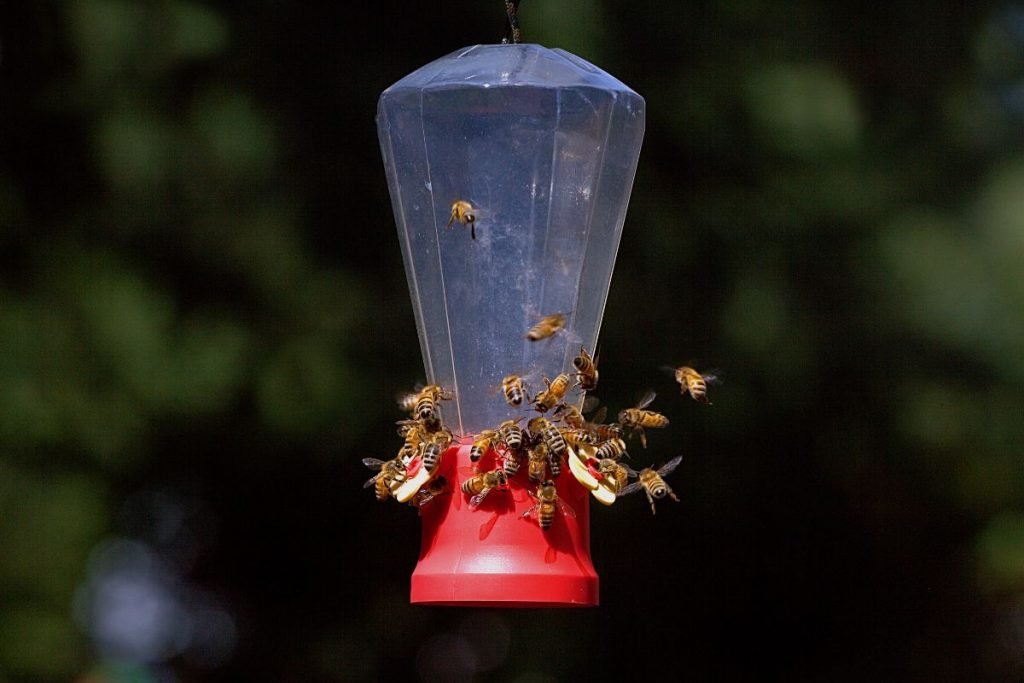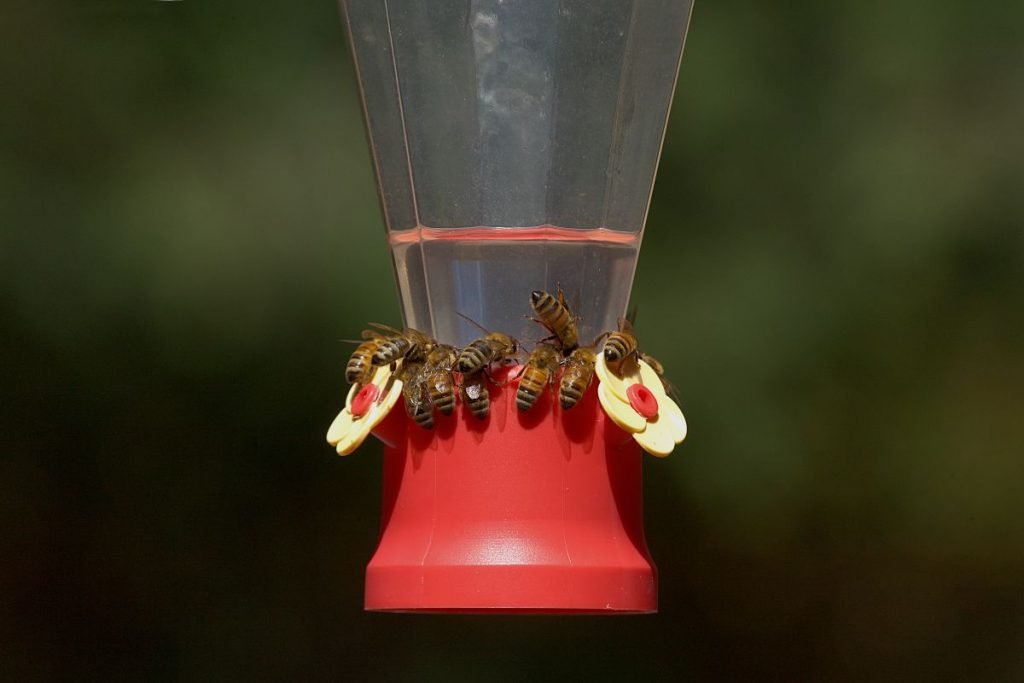Yes, hummingbird feeders attract bees because they contain sweet nectar that bees naturally seek for energy. The sugar water in these feeders mimics the nectar bees collect from flowers, making them particularly appealing during hot weather or when natural food sources are scarce.
This natural attraction to nectar makes bees frequent visitors to hummingbird feeders, especially in gardens where they compete with hummingbirds for this sweet energy source.
Many garden enthusiasts find their carefully placed feeders becoming gathering spots for bees rather than the delightful hummingbirds they hoped to attract.
It’s a common challenge that affects anyone trying to create a welcoming space for hummingbirds.
In this blog post, we will explore why bees are drawn to hummingbird feeders, how this affects your garden visitors, and most importantly, what you can do to maintain a peaceful balance between these important pollinators and your beloved hummingbirds.
Related post: Does Peppermint Oil Keep Bees Away from Hummingbird Feeders?
Key Takeaways:
- Hummingbird feeders naturally attract bees due to their sweet nectar content and design features.
- Bees are most attracted to feeders during hot weather and when natural nectar sources are scarce.
- You can minimize bee visits by using bee-resistant feeders, adjusting nectar ratios, and choosing strategic placement locations.
Related Posts:
Best Hummingbird Feeders.
Hummingbird Feeders Comprehensive Guide.

Why Bees Are Attracted to Hummingbird Feeders
Bees’ attraction to hummingbird feeders isn’t just a coincidence – it’s rooted in their natural instincts and survival needs. These industrious insects are drawn to these feeders for several compelling reasons.
First and foremost, bees have an exceptional sense of smell that allows them to detect sweet substances from considerable distances.
The sugar water in hummingbird feeders closely resembles the nectar they collect from flowers, making it an irresistible energy source for them.
The attraction becomes even stronger during certain conditions:
- Hot weather periods when natural nectar sources might be less abundant
- During ‘nectar dearth’ seasons when fewer flowers are blooming
- In areas where natural flowering plants are limited.
Related post: Do Hummingbirds Eat Bees?
Impact on Hummingbird Feeding
When bees discover a hummingbird feeder, they can create several challenges for both the birds and garden owners. Here’s what typically happens:
- Bees may swarm around the feeder, making it difficult for hummingbirds to approach
- They might monopolise feeding ports, limiting hummingbirds’ access to nectar
- Their presence can intimidate some hummingbirds, causing them to seek food elsewhere.

Effective Solutions to Manage Bee Activity
Fortunately, you can take several practical steps to reduce bee activity at your hummingbird feeders while still maintaining a welcoming environment for the birds.
Choose the Right Feeder Design
Select feeders specifically designed to deter bees while remaining accessible to hummingbirds:
- Look for models with bee guards or deep ports
- Choose saucer-shaped feeders that make it harder for bees to reach the nectar
- Avoid feeders with yellow parts, as this colour particularly attracts bees.
Adjust Your Nectar Recipe
The concentration of your sugar water can make a significant difference:
- Use a 1:5 sugar-to-water ratio instead of stronger mixtures
- Ensure the nectar is thoroughly mixed to prevent sugar settling
- Change the nectar regularly to maintain its proper consistency.
Strategic Placement and Maintenance
Where and how you maintain your feeder matters:
- Place feeders in shaded areas, as bees prefer sunny spots
- Clean up any spilled nectar promptly to avoid attracting bees
- Move feeders occasionally to prevent bees from establishing regular feeding patterns.
Create Alternative Food Sources
Consider setting up a separate feeding station for bees:
- Place a shallow dish of sugar water away from hummingbird feeders
- Plant bee-friendly flowers in a different part of your garden
- Maintain these alternative food sources consistently.
Related post: 15 Tips on How To Keep Bees Off Hummingbird Feeder.

Final Thoughts
Managing the relationship between hummingbird feeders and bees requires patience, understanding, and strategic thinking.
While it’s true that hummingbird feeders attract bees, this natural attraction can be effectively managed without harming either species.
By implementing the suggested solutions outlined above, and maintaining a balanced approach to backyard wildlife management, you can create an environment where both hummingbirds and bees thrive without significant conflict.
Remember, both species play vital roles in our ecosystem, and with thoughtful management, they can coexist harmoniously in your garden space.
Frequently Asked Questions (FAQ: Does Hummingbird Feeder Attract Bees?)
Q: Will bee guards completely stop bees from accessing my hummingbird feeder?
A: While bee guards significantly reduce bee access to the nectar, they may not completely eliminate bee visits, especially if there’s spilled nectar. Regular cleaning and proper maintenance of the guards are essential for maximum effectiveness.
Q: Is it safe to paint the yellow parts of my feeder red?
A: Yes, but you must use non-toxic, weather-resistant paint that’s safe for wildlife. Make sure the paint is completely dry before refilling the feeder, and avoid painting any parts that come into direct contact with the nectar.
Q: How often should I move my hummingbird feeder to confuse bees?
A: Moving your feeder every 2-3 days can help prevent bees from establishing a regular feeding pattern. However, ensure the new locations are still visible and accessible to hummingbirds.
Q: What’s the best time of day to clean and refill hummingbird feeders?
A: Early morning or evening are ideal times, as bee activity is typically lower. This reduces the chance of bees being attracted to the fresh nectar immediately after refilling.
Q: Can using fake flowers around the feeder ports help deter bees?
A: No, artificial flowers might actually attract more bees, especially if they’re yellow or blue. Stick to simple, red-coloured feeders without additional decorative elements.
Image of Bees on Hummingbird Feeder (Does Hummingbird Feeder Attract Bees?)




References: Hummingbird, Bird Feeder.
